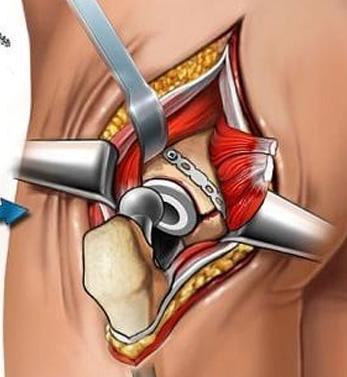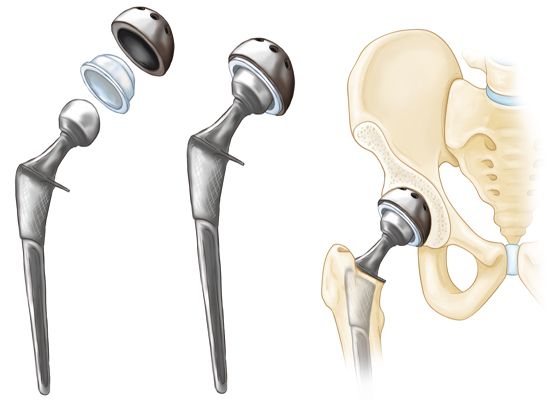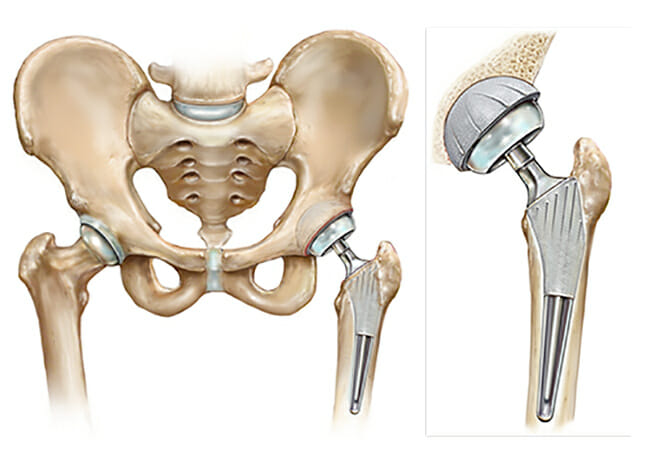





The hip joint consists of a ball and socket. The top of the thigh bone, the femoral head, defines the part called the ball, while the other part, which is made up of bone and cartilage, defines the socket. Hip replacement surgery is a procedure in which the damaged ball and socket are replaced with new and durable synthetic structures with similar properties.
 Most people who have hip replacement surgery are between the ages of 50 and 80. This surgery is usually done for the treatment of hip arthritis. Arthritis is a condition that breaks down cartilage. Without cartilage, bones rub against each other and severe pain is experienced.
Most people who have hip replacement surgery are between the ages of 50 and 80. This surgery is usually done for the treatment of hip arthritis. Arthritis is a condition that breaks down cartilage. Without cartilage, bones rub against each other and severe pain is experienced.
There are 3 types of arthritis where hip replacement is seen as a solution:
rheumatoid arthritis - an autoimmune disease that causes joint inflammation
traumatic arthritis - joint damage caused by an injury
osteoarthritis – most common degeneration in older adults
Usually, doctors use a walker or cane, a low-impact exercise program, and nonsteroidal anti-inflammatory drugs such as ibuprofen to keep arthritis in check. At the point where these measures are no longer sufficient, hip joint replacement is seen as the best solution. If you can't sleep because of pain, can't sit comfortably, or if your arthritis is limiting your daily activities, you may consider hip replacement.
Hip replacements can also be used for other health conditions. They are used, for example, in the case of a tumor in the hip joint. In emergency situations, when a fracture occurs in the hip joint or thigh bone, a hip replacement may be used to repair the fracture.
The new hip built basically has four components:
a socket made of metal
a lining structure that allows the ball to move freely in the slot
a metal or ceramic ball to replace the head of the thigh
a metal rod to which the ball will be attached (serves to stabilize the thighbone)
There are different joint prosthesis options. Although most surgeons prefer a cementless joint prosthesis, a cemented prosthesis can also be attached to the hip with bone cement for faster and more successful adhesion. Both paths show similar success rates. However, there are points where they differ in terms of improvement.
Perhaps the most important thing for your hip replacement is knowing how to choose the right surgeon for this job. Most of the time, you start the process with a referral to a surgeon. You might consider interviewing a few candidates to find the right doctor. You can ask your surgeon how many hip replacements he's had, their overall success rate, the estimated recovery time, and whether he'll be interested in your post-operative care.

How is Hip Replacement Surgery Performed?
Unless you have an emergency hip replacement, such as in an accident, your surgery is probably scheduled a few weeks in advance. Your doctor determines and waits for a period of time for your body to become as suitable as possible for the operation. In addition, you may need to lose some weight and stop using certain medications, including blood thinners. Since your movement will be limited in this process, you should minimize long distances and use of stairs and rearrange your living space. For example, you can prepare food in advance and freeze it. You can place everyday items at arm's length to avoid overexertion.
You may be told not to eat or drink anything after midnight on the day of your surgery. It is useful to pay attention to such warnings. After your controls are done on the day of surgery, your nurse will take you to a room where you need to be prepared for the surgery. When it's time to start your operation, you will be taken to the operating room. At this stage, either general anesthesia is given to you or you are prevented from feeling pain by giving another drug that allows you to sleep during the surgery.
Your surgeon should know if you have conditions in organs such as the heart or lungs that may pose a risk in general anesthesia. Accordingly, the form of anesthesia can be local or regional, and these people may also be given sedatives to help them stay calm during the surgery. The operation is completed within 1 to 3 hours.
Life After Hip Replacement Surgery
After surgery, you will be moved to a recovery area for a few hours as the anesthesia wears off. At this stage, your blood pressure, heart rate, pain level, need for medication, and waking status after anesthesia are monitored. Some people can go home the same day, but most stay in the hospital for a night or two.
PREVENT BLOOD CLOTHES
There is an increased risk of blood clots in your legs after your surgery. There are some solutions to avoid this complication. You are encouraged to walk with crutches or a walker immediately after surgery.
This will likely happen the same day as your surgery or the next day. You can wear elastic compression stockings or inflatable air sleeves on your lower legs both during and after the operation. The pressure exerted by the inflated arms prevents blood from pooling in the leg veins and reduces the likelihood of clots forming. Your surgeon may prescribe blood-thinning medications that are injected or taken orally after surgery. How easily you walk, how active you stay, and your overall risk of blood clots determine your need for blood thinners after surgery.
PHYSIOTHERAPHY
Your physical therapist will help you plan and do exercises that you can do in the hospital and at home to speed up your recovery. Activity and exercise should be an important part of your day to re-strengthen your joints and muscles. Your physical therapist will recommend strengthening and range of motion exercises. It helps you learn how to use a walking aid, such as a walker, cane, or crutches.
HEALING PERIOD AT HOME
Before you leave the hospital, you and your companions will be given tips on caring for your new hip. For a comfortable recovery and adjustment period, a friend or relative can cook for you. In addition, you can place the items that you use frequently in daily life near you. Keep your phone, tablet, TV remote and books close by, especially during the recovery period. But avoid bending over or lying down. If you have a low toilet, it may also be beneficial for you to make minor changes to your living space, such as buying a raised toilet seat. In addition to these, one of the most important elements is to keep the stair climbing to a minimum. Sit in a sturdy, straight-backed chair. Do not use recliners. To prevent falls, remove any rugs that might slide on the floor and keep rooms clutter-free.
Probably 6 to 12 weeks after surgery, your doctor will want to see you and check to make sure your hip is healing properly. By getting stronger, the time required to complete the recovery period is between 6 and 12 months.